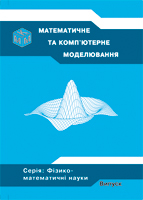Numerical Complex Analysis Method for Parameters Identification of Anisotropic Media Using Applied Quasipotential Tomographic Data. Part 1: Problem Statement and its Approximation
DOI:
https://doi.org/10.32626/2308-5878.2018-18.14-24Анотація
The approach to the solving of gradient problems of parameters identification of quasiideal fields with using applied quasipotential tomographic data based on numerical complex analysis methods is transferred to cases of anisotropic media. We, similar to the existing works of world scientists, some additional information about the nature of the distribution of conductivity inside the domain (research object) is considered a priori known. However, in opposite to the traditional approaches to the statement and solving the problems of electrical impedance tomography, we set the local velocities distribution of a substance (liquid, current) in addition to the averaged potential at the contact sections of plate and body and at other sections (stream lines), we set the potential distribution (according to experimental data, which we approximate using splines, Bezier curves, etc.). Generation of initial data at the boundary of the investigated object is carried out in accordance with the polar model of current injection and a given sum of eigenvalues of the conductivity tensor of the medium. The presence of this kind of data greatly accelerates the process of further solving the problem, which is convenient, in particular, when verifying the method that developed by authors. The corresponding problem is reduced to the iterative solving of a series of problems for the Laplace type equations, where instead of «boundary numerical analogues of the Cauchy-Riemann type equations» appear the ratio of quasiorthogonality with using special types of optimization conditions. In particular: the minimizing functional is constructed by taking into account the Cauchy-Riemann type conditions, the relation between eigenvalues of corresponding anisotropy tensor and also regularizing term; the condition-restriction is built based on ellipticity conditions.Посилання
Holder D. Electrical Impedance Tomography. Methods, History and Applications / D. Holder. — Bristol : IOP Publishing, 2005. — 456 p.
Horb M. S. Choice of the study object for mathematical model in electrical im-pedance tomography / M. S. Horb, O. V. Husieva // Bulletin of NTUU «KPI». Radiotechnique, Radioaparatus Building Series. — Kyiv : NTUU «KPI», 2013. — Vol. 52. — P. 120–128. (Ukr).
Sherina E. S. Finite volume schemes for the electrical impedance tomography problem / E. S. Sherina, A. V. Starchenko // Tomsk State University Journal of Mathematics and Mechanics. — 2014. — Vol. 29 (3). — P. 25–38. (Rus).
Bomba A. Ya. Numerical Methods of Quasiconformal Mappings for Solving Problems of Identifying of Electrical Conductivity Coefficient in an Applied Potential Tomography / A. Ya. Bomba, L. L. Kroka // Volyn Mathematical Bulletin. Applied Mathematics Series. — Rivne : Editorial and Publishing Department of RSHU, 2014. — Vol. 11 (20). — P. 24–33. (Ukr).
Bomba A. Ya. Applied Quasipotenrial Method for Solving Coefficient Problems of Parametric Identification / A. Ya. Bomba, M. V. Boichura // Bulletin of NUWEE. Technical Sciences Series. — Rivne : Editorial and Publishing De-partment of NUWEE, 2017. — Vol. 4 (76). — P. 163–177. (Ukr).
Martins T. C. Investigating Anisotropic EIT with Simulated Annealing / T. C. Martins, M. S. G. Tsuzuki // IFAC-PapersOnLine. — 2017. — Vol. 50 (1). — P. 9961–9966.
Lionheart W. R. B. Conformal uniqueness results in anisotropic electrical imped-ance imaging Inverse Problems / W. R. B. Lionheart // Inverse Problems. — 1997. — Vol. 13 (1). — P. 125–134.
Electrical impedance tomography in anisotropic media with known eigenvectors / J.-F. P. J. Abascal, W. R. B. Lionheart, S. R. Arridge and other // Inverse Problems. — 2011. — Vol. 27 (6). — P. 1–17.
Anisotropic resistivity tomography / J. V. Herwanger, C. C. Pain, A. Binley and other // Geophysical Journal International. — 2004. — Vol. 158 (2). — P. 409–425.
Crabb M. EIT Reconstruction Algorithms for Respiratory Intensive Care. PhD Thesis / M. Crabb // Manchester :University of Manchester. — 2014.
Tallman T. N. Conductivity-Based Nanocomposite Structural Health Monitoring via Electrical Impedance Tomography. PhD Thesis / T. N. Tallman // Ann Arbor : University of Michigan. — 2015.
Use of anisotropic modelling in electrical impedance tomography; Description of method and preliminary assessment of utility in imaging brain function in the adult human head / J.-F. P. J. Abascal, S. R. Arridge, D. Atkinson and other // NeuroImage. — 2008. — Vol. 43 (2). — P. 258–268.
Vassilevski Yu. V. Finite element analysis in bioimpedance diagnostics / Yu. V. Vassilevski, A. A. Danilov, D. V. Nikolaev, A. V. Smirnov // Computational Mathematics and Mathematical Physics. — 2012. — Vol. 52 (4). — P. 733–745 (Rus).
Bomba A. Ya. Complex analysis methods / A. Ya. Bomba, S. S. Kashtan, D. O. Pryhornytskyi, S. V. Yaroshchak. — Rivne : Editorial and Publishing Depart-ment of NUWEE, 2013. — 415 p. (Ukr).
The comparison between FVM and FEM for EIT forward problem / G. Dong, J. Zou, R. Bayford and other // IEEE Transactions on Magnetics. — 2005. — Vol. 41 (5). — P. 1468–1471.
ALGLIB — C++/C# numerical analysis library. URL: http://www.alglib.net (last accessed 2018/11/06).
##submission.downloads##
Опубліковано
Номер
Розділ
Ліцензія
Authors who publish with this journal agree to the following terms:- Authors retain copyright and grant the journal right of first publication with the work simultaneously licensed under a Creative Commons Attribution License that allows others to share the work with an acknowledgement of the work's authorship and initial publication in this journal.
- Authors are able to enter into separate, additional contractual arrangements for the non-exclusive distribution of the journal's published version of the work (e.g., post it to an institutional repository or publish it in a book), with an acknowledgement of its initial publication in this journal.
- Authors are permitted and encouraged to post their work online (e.g., in institutional repositories or on their website) prior to and during the submission process, as it can lead to productive exchanges, as well as earlier and greater citation of published work (See The Effect of Open Access).

